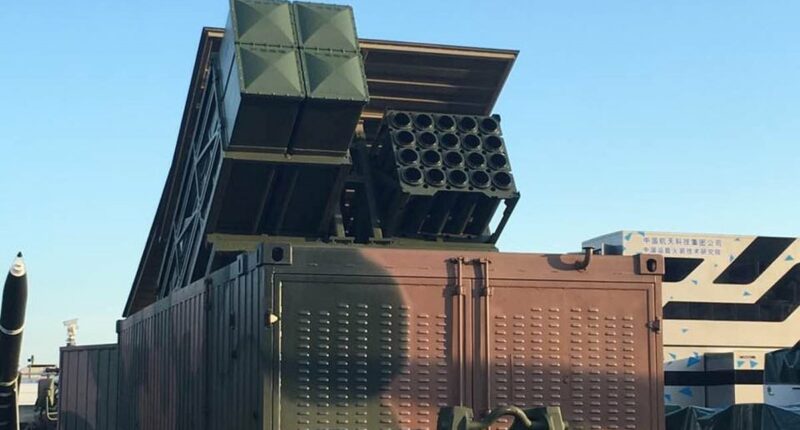Share this @internewscast.com
It looks like a regular shipping container, loaded aboard a cargo ship sailing up from the mega-port at Manzanillo.
However, behind the corrugated steel lies a cruise missile launcher and numerous combat drones, poised to deliver a surprise assault on US bases in California with devastating force.
No, this isn’t the start of a doomsday war movie — it’s one of the nightmare scenarios in a report from America’s top defense think tank.
And it’s keeping Pentagon chiefs awake at night.
The Center for Strategic & International Studies (CSIS) reports that China has subtly taken control or gained influence over 37 key seaports throughout Latin America and the Caribbean.
That’s nearly three times as many as were previously known about.
This secretive network stretches across the area, enabling Beijing to monitor US military movements, block critical shipping routes, and potentially execute an unexpected military attack on American territory.
Many of the ports are owned, operated, or financed by Chinese state-owned companies with close ties to the Communist Party and the People’s Liberation Army (PLA).
Officials in Beijing insist they are for trade and development, but experts warn the real motive is control, surveillance, and strategic dominance.
Henry Ziemer, a CSIS expert on South America, says China’s ports are ‘black boxes.’

It looks like a regular shipping container unit, but inside, Chinese weapons makers have hidden a missile launcher

China could stockpile stealth weapons at the ports it controls in the region, like this one in Manzanillo, Mexico
Beijing can wield its influence to ‘delay investigations into particular cargo shipments and hide anything from a cruise missile to weaponized drones,’ Ziemer told the Daily Mail.
‘They can keep them until the time is right to trigger the maximal attack.’ China’s mission to the UN and the Pentagon did not answer our requests for comment.
At first glance, the Chinese investments in the Americas are economic — Beijing gets access to corn, sugar, soybeans and other exports and reduces its reliance on the US.
In return, Latin America and the Caribbean governments get investment and know-how in upgrading their ramshackle infrastructure.
But the CSIS report shows the pattern is more widespread and dangerous than was understood.
Through these ports, China can also monitor maritime traffic, collect sensitive data on US military and commercial shipping, and expand its leverage over fragile democracies.
Chinese involvement in Panama’s ports has already attracted the ire of the Trump administration, thanks to their proximity to the Panama Canal.
President Donald Trump in February announced plans to ‘take back’ US control of the canal, citing Beijing’s clout in a route for 40 percent of US container traffic each year.
But CSIS researchers say there are bigger threats along Latin America’s coastline, and highlight the port of Kingston, in Jamaica
It is fully controlled by the state-owned China Merchants Port Holdings, lies close to US military bases, and gives Beijing influence in a historic US ally, says the report.
Chinese firms also run Mexican ports at Veracruz and Manzanillo, meaning they could disrupt shipping to US ports worth $193 million every day, says CSIS.
Beijing is not likely to start a military build-up at its ports for an attack on the US right away, researchers said — as that would risk a geopolitical crisis.

Chinese President Xi Jinping inaugurated the Chancay Port megaproject with his Peruvian counterpart Dina Boluarte in Lima in November

Xi called the $1.3 million China-funded scheme at Chancey a ’21st-century maritime Silk Road’

Chancey is one of 37 China-linked port schemes across the hemisphere, according to the Center for Strategic & International Studies (CSIS)
But they could be putting stealth weapons in place for sneaky strikes in the future, says Ziemer.
Chinese defense firms have been hiding cruise missile launch systems in ordinary container units since at least 2016.
More recently, they’ve experimented with drones, which can be packed into freight holds ready for a surprise attack.
That’s how Ukraine destroyed warplanes in eastern Russia and Israel launched surprise attacks on Iranian nuclear sites in June.
The prospect echoes the Cuban Missile Crisis, but this time it may not involve conspicuous missile silos — just an unassuming red container marked ‘Huawei Electronics’ or ‘State Grid Tools.’
Though a conflict between Washington and Beijing looks far off, a Chinese assault on Taiwan could come sooner than expected and spill over into a wider conflict.
Chinese President Xi Jinping reportedly wants his forces to be ready to invade Taiwan by 2027 in a move that could draw a fierce American response and kickstart World War III.
Until then, experts say Beijing will use their ports to control supply chains, gather intelligence, and amass diplomatic clout in the hemisphere.
‘We should assume that the Chinese military will try to use many of these ports as military nodes,’ Gabriel Noronha, a former State Department advisor and president of Polaris National Security, told the Daily Mail.
‘To monitor US assets or even use them to smuggle their own assets in to attack US vessels and forces.’
Of the 37 ports identified in the CSIS study, 10 are owned or operated by Chinese firms — seven of them alone by the Hong Kong–based holdings company CK Hutchison.
Others feature Chinese-made cranes, cargo scanners and other gear that can be used for nefarious purposes, says CSIS.

Armed Chinese units have been experimenting with drones for combatting terrorists and more complicated military operations

CSIS researchers identified the port of Kingston, Jamaica, as the most threatening Chinese project to US interests
Cranes made by Shanghai Zhenhua Heavy Industries can gather and transmit sensitive data and could be used to disrupt ports during a crisis.
Likewise, cargo scanners made by state-owned Nuctech can gather sensitive biometric, logistical, and trade data, and beam it back to Beijing.
The US federal government has banned them, but they’re common across Latin America and the Caribbean.
China’s growing influence in South American ports became impossible to ignore in November, when President Xi inaugurated Chancey, a deep-water mega-port in Peru.
He called the $1.3 million China-funded scheme a ’21st-century maritime Silk Road.’
At the time, Gen Laura Richardson, former US Southern Command chief, said the Chinese military could use Chancay for intelligence-gathering.
Three months later, China’s seaport spree was debated in the House as a threat to the Monroe Doctrine — the 19th Century principle that foreign powers keep out of America’s backyard.
Carlos Gimenez, the Florida Republican who chairs the Subcommittee on Transportation and Maritime Security, warned of deals in Cuba, Peru, Brazil, and Ecuador.
‘The Chinese Communist Party has no rightful place in shaping the economic and security landscape of our region,’ Gimenez said.
Many of the projects are funded with opaque loans from Chinese state banks, often locking smaller nations into long-term debt dependency.
In many cases, China insists on control over port operations, technology systems, or security procedures.
This gives Beijing enormous soft power — the ability to pressure governments, silence criticism, and extract favors, all while expanding its Belt and Road Initiative (BRI) into the Western Hemisphere.

Ukraine smuggled combat drones deep into Russia with devastating effect in June

Cranes made by Shanghai Zhenhua Heavy Industries can gather and transmit sensitive data
CSIS researchers say the Trump administration should take the threat seriously and act before it’s too late.
US firms should buy up ports, and American diplomats should nudge allies to keep tabs on their Chinese investors and any suspect cargo.
A looming $23 billion deal that would see Hutchison sell 43 of its overseas ports, including the seven across Latin America and the Caribbean, to a consortium led by US-based BlackRock, would limit China’s reach.
But Beijing has objected to the deal, and China’s state-owned COSCO Shipping is vying for a stake.
‘If the BlackRock deal goes through it would significantly decrease the risk, but it would not go to zero,’ says Ziemer.
‘The ports would still operate the cranes and scanners that can transmit data back to Beijing.’
With Chinese influence creeping ever closer to US shores — and potentially docking inside its own ports — the once-theoretical threat of a global confrontation is becoming frighteningly real.

















